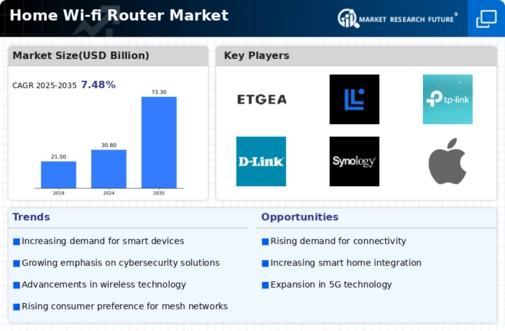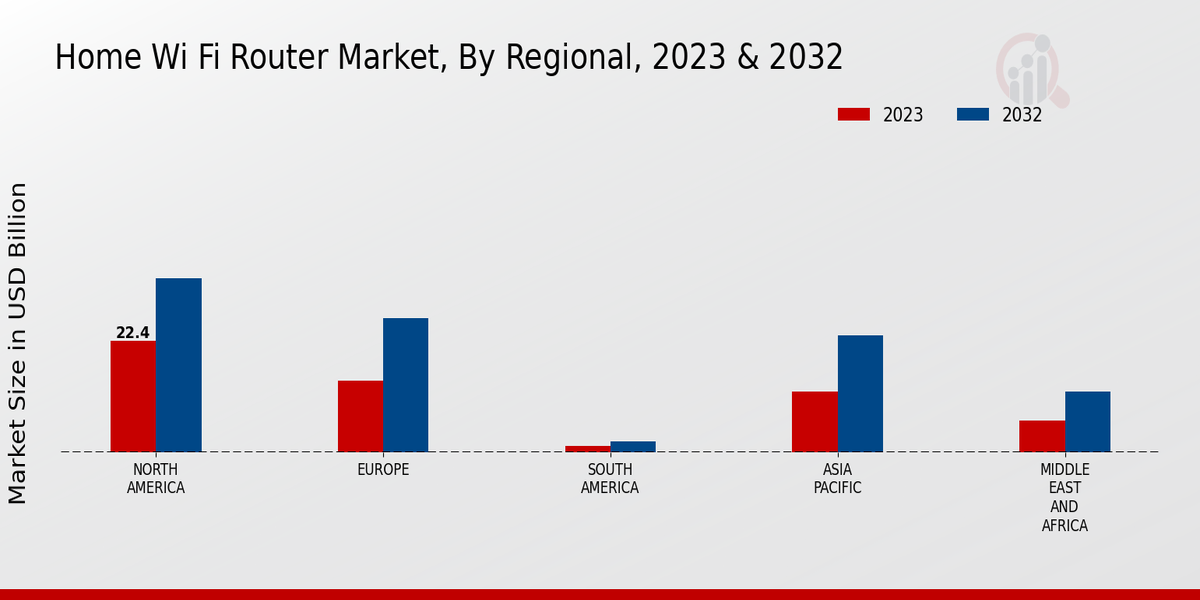Market Growth Projections
The Global Home Wi-fi Router Market Industry is poised for substantial growth, with projections indicating a market value of 30.8 USD Billion in 2024 and an anticipated increase to 73.3 USD Billion by 2035. This growth trajectory suggests a compound annual growth rate of 8.2% from 2025 to 2035, driven by various factors including rising internet penetration, the proliferation of smart home devices, and the increasing demand for high-speed internet. These projections highlight the dynamic nature of the market and the potential for innovation and investment in home networking solutions.
Rising Internet Penetration
The increasing rate of internet penetration globally serves as a primary driver for the Global Home Wi-fi Router Market Industry. As more households gain access to the internet, the demand for reliable and efficient Wi-fi routers escalates. In 2024, the market is projected to reach 30.8 USD Billion, reflecting the growing need for connectivity. This trend is particularly evident in developing regions, where internet adoption is surging. Enhanced online activities, such as streaming and gaming, further amplify this demand, necessitating advanced router technologies to support multiple devices simultaneously.
Growth of Smart Home Devices
The proliferation of smart home devices significantly influences the Global Home Wi-fi Router Market Industry. As consumers increasingly adopt smart appliances, security systems, and IoT devices, the need for robust Wi-fi networks becomes paramount. These devices often require stable and high-speed internet connections to function optimally. The market is expected to expand as households integrate more smart technologies, driving the demand for advanced routers capable of managing increased traffic. This trend indicates a shift towards more sophisticated networking solutions, which could lead to a market valuation of 73.3 USD Billion by 2035.
Increased Remote Work and Learning
The shift towards remote work and online learning has catalyzed growth in the Global Home Wi-fi Router Market Industry. As individuals and families adapt to new work and educational environments, the demand for reliable home Wi-fi solutions has surged. This trend necessitates routers that can handle multiple simultaneous connections without compromising speed or reliability. The market's growth trajectory suggests a compound annual growth rate of 8.2% from 2025 to 2035, driven by the ongoing need for efficient home networking solutions that support both professional and educational activities.
Growing Demand for High-Speed Internet
The escalating demand for high-speed internet access is a critical driver of the Global Home Wi-fi Router Market Industry. As consumers increasingly rely on high-bandwidth applications, such as 4K streaming and online gaming, the need for routers that can deliver exceptional performance becomes vital. This demand is reflected in the market's expected growth to 30.8 USD Billion in 2024. Internet service providers are also enhancing their offerings, which further stimulates the need for advanced routers that can maximize the benefits of high-speed connections. This trend underscores the importance of investing in quality networking equipment.
Technological Advancements in Router Technology
Technological innovations in router technology are propelling the Global Home Wi-fi Router Market Industry forward. The introduction of Wi-fi 6 and upcoming Wi-fi 7 standards offers enhanced speed, capacity, and efficiency, catering to the increasing demands of modern households. These advancements enable routers to support a higher number of connected devices, which is crucial as smart home ecosystems expand. As consumers seek routers that provide superior performance and coverage, the market is likely to witness significant growth, aligning with the projected increase in market value to 73.3 USD Billion by 2035.














